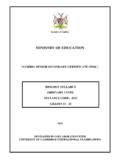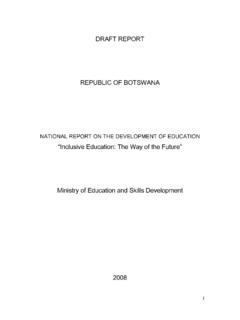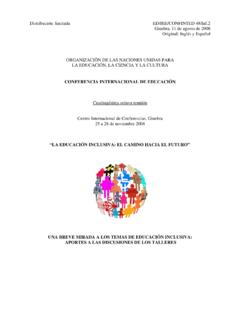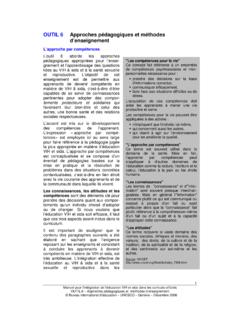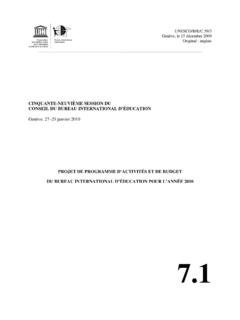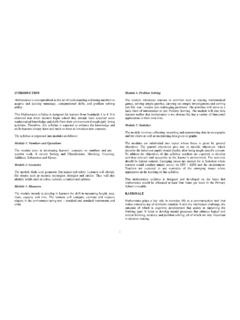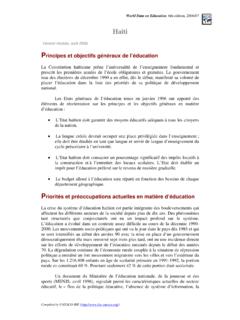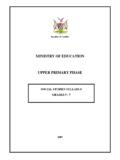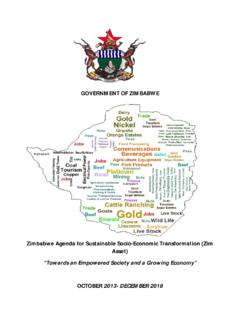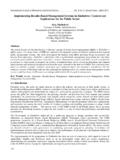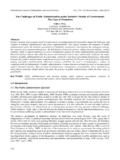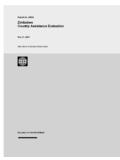Transcription of THE DEVELOPMENTS IN EDUCATION: THE …
1 UNESCO INTERNATIONAL BUREAU OF education . THE DEVELOPMENTS IN education : THE education . SYSTEM AT THE END OF THE 20TH CENTURY. 1990-2000. NATIONAL REPORT OF. THE REPUBLIC of zimbabwe . PREPARED. BY. THE zimbabwe NATIONAL COMMISSION FOR UNESCO, THE MINISTRY OF education , SPORT AND CULTURE. AND. THE MINISTRY OF HIGHER education AND TECHNOLOGY. HARARE JULY 2001. CONTENTS PAGE. INTRODUCTION 3. Socio-economic and Political Context 3. The Country's Educational Goals and Objectives 6. The Structure of the Report 7. THE education SYSTEM ST THE END OF THE 20TH CENTURY 7.
2 Major Reforms and Innovations Introduced in the education System During the Last Ten Years 7. The Legal Framework of education 7. The Organisation, Structure and Management of the education System 9. Overall Organisation and Structure of education 9. Basic education 11. Secondary education 11. Tertiary education 12. Curriculum Content and Learning strategies for the Twenty-First Century 13. Curriculum development , Principles and Assumptions 13. Aims of Curriculum development 13. Objective of Curriculum development 14. Curriculum Decision-making Process 14.
3 Curriculum Planning and Design 15. Time Allocation 16. Teaching and Learning Strategies 18. Assessment Policies, Methods and Instruments 19. Primary and Secondary Level 19. Tertiary Level 20. Changing and adapting Educational Content 21. Principal Institutions and Individuals Participating in the Process of Changing and adapting Educational content 22. Strategies Adopted in the Design, Implementation and 1. Evaluation of Curriculum Reforms 23. Curricula Achievements, Problems Encountered and Solutions 23. Objectives and Principal characteristics of the Current and Forthcoming Reforms 25.
4 Major Achievements in the Period 1990 to 2000 26. Access to education 26. Equity in education : Primary Sector Gender Participation 29. Equity in education : Secondary Sector Gender Participation 31. Equity in education : Tertiary Level 32. The Reduction of Unqualified Teachers 33. Quality and Relevance of education 34. Decentralisation: Participation by society in the Process of Educational Change 35. The Main Problems and Challenges Facing National education at the Beginning of the 2!st Century 35. CONCLUSION 39. REFERENCES 40. 2. INTRODUCTION.
5 At the dawn of the last decade of the twentieth century, zimbabwe had two ministries of education : the Ministry of education , Sport and Culture, and the Ministry of Higher education and Technology. The Ministry of education , Sport and Culture organises, structures and manages education from pre-primary to secondary school level. The Ministry also deals with non-formal education and adult literacy, and technical, vocational and commercial education at secondary school level. The Ministry of Higher education and Technology organises and manages tertiary education focusing on teacher, technical, vocational and university education .
6 The activities and DEVELOPMENTS within this sector during the period 1990-2000 were within the scope of the national development plans such as the Economic Structural Adjustment Programme (ESAP) and the zimbabwe Programme for Economic and Social Transformation (ZIMPREST). Socio-economic and Political Context The country's economy is agro-based and it also has a vibrant tourism sector. Other major sectors are manufacturing and mining. Some of the main minerals found in zimbabwe include gold, nickel, chromium ore, iron ore and coal The population of zimbabwe as at the 1992 national Census stood at 10 401 767.
7 The annual population growth rate for the period 1990 to 1992 was The population density was persons/Km2. By 1997 when the Inter Censal Demographical Survey (ICDS) was carried out the population had risen to 11 789 274. 52,1% were women. This reflected an average population growth rate of 2,5% The population density had risen to 30/Km2. The ICDS also revealed some inequalities in the population the literacy rate was higher in males (90%) than among the female population (80%). The national literacy rate stood at 86%. Government expenditure on education has been quite substantial over the years.
8 Just after 1980, budget allocations to the sector were quite high since the government was on a drive to redress the imbalance that had been the norm during the colonial era. Unfortunately, the bulk of government expenditure on the sector is still mainly on 3. salaries, which accounts for 90% of the education budget. Expenditure on the two education ministries is now almost 40% of the national budget. In 1980 the new government of zimbabwe inherited a system of education that was racially biased and unequal in both governance and financing as well as the quality it rendered to the different racial groups.
9 For example, the colonial settler government made European education compulsory and therefore offered universal education , spent as much as 20 times more per European child than the African child. Mainly missionaries rather than government provided education , for the African child. During the first decade of zimbabwe 's independence, the government followed a socialist path. The main driving principle was "Growth with Equity". This principle was adopted so that the government could redress the inherited inequities and imbalances in access to basic needs such as education and health facilities and services.
10 During this period, the government played a major role in the provision of services as well as in the redistribution of resources. For the period 1982 1992 the GDP growth at 2,7% lagged behind the population growth rate of 3,13%. Unfortunately a disproportionate share of this growth was in the provision of services and public administration. The overall export growth for the period 1980 - 1989 was very low at 3,4%. The debt service payments were as high as 34% of export earnings by the end of the 1980s. This had a negative impact on foreign currency earnings and reserves such that stringent foreign currency control measures were introduced.

